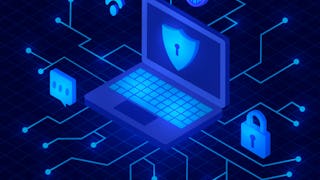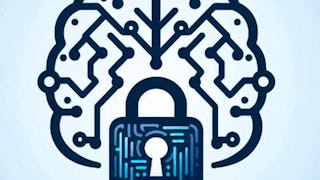The AI for Cybersecurity course offers a comprehensive introduction to the usage of AI methods, most specifically machine learning in the field of cybersecurity. It begins with an introduction to AI, covering its definitions, historical development, and general applications. The course then discusses the importance of AI in cybersecurity, introducing key concepts, and the distinction between the host security and the network security.
通过 Coursera Plus 解锁访问 10,000 多门课程。开始 7 天免费试用。


您将获得的技能
- Intrusion Detection and Prevention
- Anomaly Detection
- Threat Detection
- Cyber Threat Intelligence
- Artificial Intelligence
- Cybersecurity
- Supervised Learning
- Information Systems Security
- Deep Learning
- Artificial Intelligence and Machine Learning (AI/ML)
- Natural Language Processing
- Malware Protection
- Data Ethics
- Machine Learning
要了解的详细信息

添加到您的领英档案
September 2025
21 项作业
了解顶级公司的员工如何掌握热门技能

该课程共有4个模块
Welcome to the introductory part of the AI and Cybersecurity course! During the 5 video lectures and 2 readings of this module you will find various definitions of the Artificial Intelligence, the evolution of this domain and the classification of the AI algorithms in search-based algorithms and intelligent systems. The domains where AI is successfully used are presented, with focus on the use of AI in cybersecurity related tasks (e.g.: network analysis, intrusion detection, malicious web link detection, anomaly detection or malware classification ). Afterwards, the basic concepts of cybersecurity will be introduced, and the classification of security threats at endpoint level or internet level. You will discover types of cybersecurity threats and how they can be defended.
涵盖的内容
12个视频7篇阅读材料7个作业1个讨论话题
Welcome to the second module of the AI for Cybersecurity course. This module consists of five lessons that explore different AI techniques and their applications in cybersecurity. It begins with an introduction to Machine Learning (ML) and its three basic types. The second lesson discusses three key cybersecurity tasks and explains how ML can be applied to address them. In the third lesson, you will follow a practical example of implementing and evaluating a malware detection system using two ML models: Decision Trees and Random Forests. The fourth lesson introduces fundamental concepts of deep learning (DL) and its applications in cybersecurity. Finally, the module concludes with an overview of Natural Language Processing (NLP) and how it can be used for cybersecurity-related tasks.
涵盖的内容
31个视频2篇阅读材料10个作业
This module explores how AI techniques are applied to detect and mitigate online threats. It begins with an overview of malicious web links, explaining how they redirect users, run harmful code, and spread misinformation like fake news and phishing content. Detection methods are categorized into dynamic (e.g., sandboxing, honeypots) and static (e.g., URL analysis, blacklists, machine learning models). The module also details how URLs can be analyzed through lexical, host-based, and social media features. A special focus is given to Domain Generation Algorithms (DGAs), which malware uses to create deceptive domain names. Detecting DGAs is challenging and involves either manual feature extraction or automated learning methods. Another topic of this module is detecting fake news using deep learning modules. Finally, the presentation briefly talks about clickbait detection. Real-world case studies and research-backed solutions are presented throughout. By the end, learners are equipped to recognize key cyber threats and understand the AI models used to counter them.
涵盖的内容
5个视频1篇阅读材料2个作业
This final module explores the ethical challenges and legal frameworks surrounding the use of AI in cybersecurity. Key concepts such as safety vs. security, risk management, and the balance between privacy and protection will be discussed. We will introduce the AI4People framework - autonomy, non-maleficence, beneficence, justice, and explainability - and examine its application to real-world cyber threats. The module also covers key regulations such as the EU AI Act, NIS2, the Cyber Resilience Act, and DORA, along with ethical guidelines from ACM, IEEE, and ISSA. Finally, we'll look at future trends, including open-source collaboration, ethical hacking, and global cooperation in securing AI systems. By the end, learners will understand the ethical and regulatory landscape and be prepared for the evolving challenges of AI in cybersecurity.
涵盖的内容
3个视频2篇阅读材料2个作业
提供方
从 Algorithms 浏览更多内容
 状态:免费试用
状态:免费试用Johns Hopkins University
 状态:免费试用
状态:免费试用Johns Hopkins University
 状态:免费试用
状态:免费试用
人们为什么选择 Coursera 来帮助自己实现职业发展




常见问题
To access the course materials, assignments and to earn a Certificate, you will need to purchase the Certificate experience when you enroll in a course. You can try a Free Trial instead, or apply for Financial Aid. The course may offer 'Full Course, No Certificate' instead. This option lets you see all course materials, submit required assessments, and get a final grade. This also means that you will not be able to purchase a Certificate experience.
When you purchase a Certificate you get access to all course materials, including graded assignments. Upon completing the course, your electronic Certificate will be added to your Accomplishments page - from there, you can print your Certificate or add it to your LinkedIn profile.
Yes. In select learning programs, you can apply for financial aid or a scholarship if you can’t afford the enrollment fee. If fin aid or scholarship is available for your learning program selection, you’ll find a link to apply on the description page.
更多问题
提供助学金,





